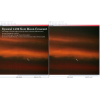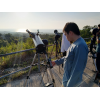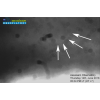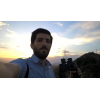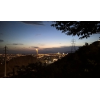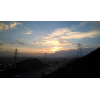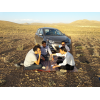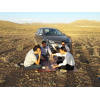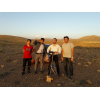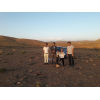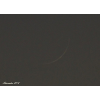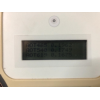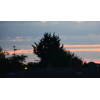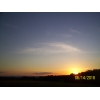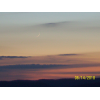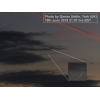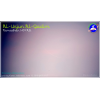Visibility of Shawwal Crescent 1439 AH
- When to Observe Shawwal Waxing (NEW) Crescent ?
- Shawwal Waxing (NEW) Crescent Observation Results
- The OFFICIAL First Day in Different Countries
- When to Observe Ramadan Waning (OLD) Crescent ?
- Ramadan Waning (OLD) Crescent Observation Results
When to Observe Shawwal Waxing (NEW) Crescent ?
The geocentric conjunction (Geocentric New Moon) will occur Inshalla on (Wedensday 13 June 2018) at 19:43 UT.
Sighting the new crescent on (Wedensday 13 June 2018) and (Thursday 14 June 2018) is shown in the below graphs using the program Accurate Times by Mohammad Odeh according to Odeh criterion. Where:-
- It is impossible to see the crescent from the areas located under the red color. Because either the Moon on this day sets before the Sunset and/or the topocentric conjunction occurs after the Sunset.
- The crescent is expected to be seen by optical aid only from the areas located under the blue color.
- The crescent is expected to be seen by optical aid from the areas located under the magenta color. In these areas the crescent could be seen by naked eye if the atmospheric conditions are superb and the observer is experienced.
- The crescent is expected to be easily visible by naked eye from the areas located under the green color.
- The crescent cannot be seen from uncolored areas, even though the Moon sets in these locations after the Sunset and the topocentric conjunction occurs before the Sunset, but the Moon is not sufficiently illuminated in order to be seen as crescent even by optical aid.
- Kindly notice that the below graph shows the possibility of seeing the crescent from areas between 60 degrees north of Equator down to 60 degrees south of Equator.
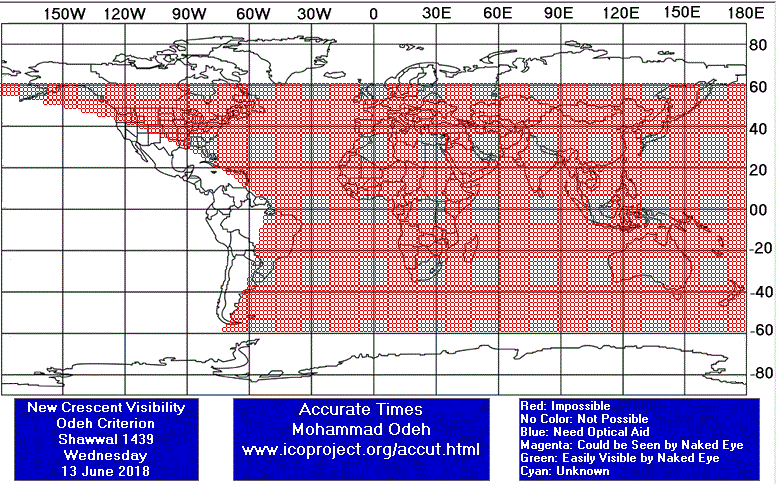

According to the Universal Hejric Calendar (UHC), which is based on the calculated crescent visibility, the start of this month in the Eastern Region will be on Friday 15 June 2018 and in the Western Region will be on Friday 15 June 2018. Kindly notice that the UHC is a pre-calculated calendar, which adopts a certain criterion to start the new Hejric month. Your country/organization might adopt different criterion to start the new Hejric month. So it is highly advised to read the UHC website before giving any judgment.
- Results of seeing the crescent, and the first day of the month in different countries will be added here Inshalla as we receive the reports from ICOP's members. If you wish to be a member in ICOP, or to know more about it, kindly click here.
Shawwal Waxing (NEW) Crescent Observation Results
Thu 14 June 2018
Algeria
Dr. Abdallah Ouragh said: "تمت رؤية الهلال على الساعة 20:26 بالتوقيت المحلي في منطقة بالوح ببريان ولاية تغردايت (غرداية) باستخدام المنظار المزدوج وتم التقاط صورة له باستخدام كاميرا Canon EOS 6D Mark II مع عدسة Samyang 650-1300"
Mr. Merouane Ali Khoudja said: "على الرغم من تنقل اعضاء الجمعية العلمية الفلكية البوزجاني إلى علوي 1240 متر. إلا أن الغيوم والغبار في مستوى الأفق حال دون رؤية الهلال."
Australia
Brunei Darussalam
Mr. Hazarry Haji Ali Ahmad said: "The western horizon was pretty clear and venus was visible late afternoon, but it was very windy and cloudy (from altitude about 6 degree and below) near the horizon where the moon was located. The 15 hour old Syawal 1439H new moon crescent was sighted during the new moon observation from Theodolite and CCD for only few seconds at around 6.53 pm (20 minutes after sunset) yesterday (Jun 14, 2018) from Bukit Agok, Tutong, Brunei Darussalam."
Germany
Eng. Martin Elsaesser said: "After observing the crescent with the video system during the day, i tried to see the crescent visually AFTER sunset. I could see it with a telescope at 35x and followed it. It was not easy to see but using several techniques still gave a 100% certain result. Still, i could not see it with 8x binoculars and had no chance to see it with naked eye under these conditions."
Eng. Martin Elsaesser said: "After months of bad weather i could finally do another crescent observation. The crescent was easily IMAGED with the videosystem, about 3 hours BEFORE sunset. I tried to see it visually with the same telescope (at 30x) but could not, the weather was not good enough for that. I hope to succeed at visual observation after sunset."
Ghana
Mr. Abdul-Aziz Anyang said: "Since countries at the eastern side of Ghana have seen the new crescent for Shawwal, eid for Ghana is Friday June 15. Eid Mubarak"
Indonesia
Mr. AR Sugeng Riyadi said: "The crescent was observed from Assalaam Observatory, Indonesia. The appearance of the crescent was slightly disturbed by the thick cloud. The poor maintained and poor prepared optical equipment that is used in this observation also contributes to the crescent "
Mr. AR Sugeng Riyadi said: "The Hilal of Shawal 1439 AH was NOT SIGHTED on Thursday, June 14th, 2018 from Assalaam Observatory at The Modern Boarding School of Islam ASSALAAM, Pabelan Kartasura Sukoharjo Central Java Indonesia because the sky was cloudy. This event was attended by Director of PPMI Assalaam, CASA members, Students of UIN Walisanga Semarang, Moslems and Local Jurnalists. However, based on the reports from BMKG Team from Palu anda Manafo also from Karya Island Jakarta by ISRN UHAMKA (photo : it was only seen by ccd not by naked eye), LAPAN Pasiruan and several NU locations Gresik and Lamongan, the Ministry of Religious Affairs of the Republic of Indonesia in the Sidang Isbath decided that Shawwal 1st, 1439 A.H starts on Friday, June 15, 2018."
Iran
Mr. Hossein Janghorbani said: "Mr Reza Janghorbani based in the city of Tabriz in East Azerbaijan province due to hazy and partly cloudy weather, Not see the crescent moon "
Mr. Hossein Janghorbani said: "In the name of God Shawwal Crescent Observation Report The Astronomy and Geophysics Center of Shahreza – The Crescent Association of Shahreza-The Astronomy Center Of Khomeynishahr Isfahan Report by: Hossein Janghorbani (NajmoSepehr-Sadrolmonajjemin) – Manager of Shahreza Crescent Association and Red Crescent’s Astronomy and Geophysics Center Date: Thursday, 06/14/2018 Location: Damzad foothills in the East of Shahreza (latitude: 32 00 N, longitude: 51 52 E, elevation: 1825m from sea level, time zone: +4.5 GMT) Equipments: Two set of 15*70 binoculars, One set of 7*50 binoculars, one sets of 20*60 binoculars , One set of 20*90 binoculars, One set of 25*100 binoculars, Three set of 20*80 binoculars, one telescope 10 inch, One compass. Atmospheric condition: Hazy Horizon obstacles: about 2/5° Apparent Sunset: 19:55 Apparent Moonset:20:32 Results: Moon crescent was seen by 20*90 binoculars by Ali Janghorbani at 20:30,20:31,20:32 for the first time. At the end, Festival Seventh spring Ramadan was held Observers: 1.Poua Karimi2.Ali Rezaiee3.Hosein Kakooie4.Hamze Sarami 5.Ali Saffari 6.Ali Dehghani7.Akram Jalali 8. Alireza Ebrahimi 9.Mohamadhadi Mokhtari10.Arash Karbalee 11.Eerfan Ghasri12.Shaghaiegh Hajheidari13.Amir Shahi14.Fateme Soltani15.Marym Eetemadzade16.Shirin Asghari17.Negar Kamali18.Kobra Eetmad zade 19.Masood Mehrabi 20.Mohamad Shiravi 21.Fatame Noori Zade22.Hasan Mofidi23.Melica Mofidi24.Hengame Saghaifi25.Amirhosin Aghaiee26.Pardis Ghasri27.Amirreza Hajeian28.Zahra Peimani29.Sepide Rahimi 30.Amirreza Rahimi31.Mohtaram Ameli32.Faremesadat Dadvar33.Zahra Aghaiee34. Zahra Zamani35 Zahra Aaskari36.Milad Baghlavaiee37.Majid Aghadavoodi 38.Aliraza Sotoode39.Amirhodein Hajeian40.Behzad Jamsheedinejad41.Mehdi Talebi42.Arezoo Janghorban43.Misagh Alinejad44.Parisa Ghadimi45.Zinat Ghermezi46.Paria Sabzevari47.Ziba Hafar48.Mojtatba Heidarpour49.Ali Fakhre50.Masome Hafar52.Mohadese Alinezhad53.Maryam SHahcheraghi54.Roya GHermezi55.Zohre Karimpor56.Ezat Nazariat57.Shiva Ansaripor58.Soheila Eslami59.Maryam Samee60.SHahide Torabi61.Taktom Torabi62.Reihaneh Dadvand63.Zahra Falahi64.Najme Nosrati65.Mohamadjavad NiKeghbal66.Mohamadsadra NiKeghbal67.Ali Janghorbani68.Aliakbar Takee69.Abdolreza GHolami70.Saer Aliabedi71.Poya Hafar72.Parham Sabzevari73.Roholah Molaeian74.Ehsanali Alinezhad75.Ahmadreza Amire76.Abasali Mokhtare77.Ahmad ahmati78.Amirali Sayadi79.Rasol Sayadi80.Amirabas Sayadi "
Mr. Hossein Janghorbani said: "In the name of God Shawwal Crescent Observation Report The Astronomy and Geophysics Center of Shahreza – The Crescent Association of Shahreza Report by: Hossein Janghorbani (Najmosepehr-Sadrolmonajjemin) – Manager of Shahreza Crescent Association and Red Crescent’s Astronomy and Geophysics Center Date: Thursday, 06/14/2018 Location: 40 kilometers far from shahreza to Semirom called khorusgelu (latitude: 31° 38' N, longitude: 51° 42' E, elevation: 2581 m from sea level, time zone: +4.5 GMT) Equipments: One sets of 15*70 binoculars , One compass. Atmospheric condition: Hazy. Horizon obstacles: 2° Apparent sunset: 20:01 Results: Moon crescent was seen by 15*70 binoculars by Hossein Janghorbani at 20:19,20:25,20:39 for the first time. Observers: 1.Dr Saman Ghasemi 2.Reza Parandeh 3.Iman Khani 4.Sayed Hesam Ahli 5. Hossein Janghorbani "
Mr. Hossein Janghorbani said: "In the name of God Shawwal Crescent Observation Report The Astronomy and Geophysics Center of Shahreza – The Crescent Association of Shahreza Report by: Hossein Janghorbani (Najmosepehr-Sadrolmonajjemin) – Manager of Shahreza Crescent Association and Red Crescent’s Astronomy and Geophysics Center Date: Thursday, 06/14/2018 Location: 40 kilometers far from shahreza to Semirom called khorusgelu (latitude: 31° 38' N, longitude: 51° 42' E, elevation: 2581 m from sea level, time zone: +4.5 GMT) Equipments: One sets of 15*70 binoculars , One compass. Atmospheric condition: Hazy. Horizon obstacles: 2° Apparent sunset: 20:01 Results: Moon crescent was seen by 15*70 binoculars by Hossein Janghorbani at 20:19,20:25,20:39 for the first time. Observers: 1.Dr Saman Ghasemi 2.Reza Parandeh 3.Iman Khani 4.Sayed Hesam Ahli 5. Hossein Janghorbani "
Libya
Morocco
Eng. Qamar Uddin said: "Hilal of Shawwal 1439 was not sighted by binoculars or by naked eye from Marrakech (Morocco), but it has been easily sighted from many other places South of Marrakech including Dakhla. Eid ul Fitr in Morocco will be tomorrow Fri 15 June 2018. Our Marrakech group included Hafiz Dr Ayyub Patel, Imad Ahmed, Qamar Uddin from UK and 10 local observers to include councillors and ministry officials"
Mr. Zakaria Samir said: "تم الإعلان عن انطلاق الشهر الهجري الجديد يوم 14 يونيو بعد مشاهدته في مناطق أخرى من المغرب. بالنسبة لمدينة أكادير كانت الأجواء بسحب منخفضة."
Dr. Hassan Talibi said: "السلام عليكم تعذرت رؤية الهلال في بنسليمان لكنها ثبتت في مناطق أخرى وقد أعلن وزارة الأوقاف عن ثبوت رؤيته ثبوتا شرعيا."
Mr. Abdessamad Doukkane said: "راقبت جمعية المبادرة المغربية للعلوم والفكر هلال شوال مع مندوبية الأوقاف والشؤون الاسلامية بالناضور بصومعة المسجد الكبير ولم تثبت رؤيته بالناضور. وقد أرسل صديق من مدينة الداخلة إسمه الأستاذ عبد الهادي أقرندو هذه الصورة للهلال"
Eng. Abdelhafid Bani said: "لم أتمكن من رؤيته بسبب الغيوم لكن وردني أنه تمت رؤيته في الجنوب"
Nepal
Mr. Mohammad Aamir said: "On Thursday, 14 June 2018, many people tried to see the moon, but moon was not seen from Nepali Jame Masjid, Kathmandu, Bagmati, Nepal (Cloudy and Rainy condition) or anywhere from Nepal. TIME OF SIGHTING EFFORT: from 6:50 pm to 7:30 pm. Official Announcement: Darul Ifta wal Qaza, Nepai Jame Masjid declared Saturday, 16 June 2018 the first day of Shawwal and Eid day for all over Nepal."
Nigeria
Mr. Usman Dukku said: "Though I could not see the crescent, many people sighted it in different parts of the city (Bauchi, Nigeria)."
Dr. Usman El-Nafaty said: "The western horizon was mildly cloudy but clear here in Bauchi city Nigeria at the time of Sighting. I was in a group of few people and because the crescent was low, not all members of the group saw the crescent. Alhamdu Lillah and EID Mubarak."
Oman
Eng. Mundhir AlShibani said: "The Crescent was seen by other team members in different location, however it was not visible from the city."
Prof. Mohammed Al-Bussaidi said: "The sky was dusty and hazy and the crescent was only observed using telescope + CCD. "
Palestine
Saudi Arabia
Mr. Turki Alamri said: "I tracked the crescent with my telescope and my ccd , after sunset we managed to see it through the eyepiece the we waited for more minutes to see it through binoculars and then i am the only one managed to see it with my naked eyes for a few minutes . there were three guys with me with no expert , they just came to observe with me , my sunphotometer value just half an hour before sunset is 0.02 aod !!! "
Mr. Turki Alamri said: "It was easy to capture the new born crescent with aod 0.17 during daylight "
South Africa
Spain
Mr. Abdel Karim Al-Saraqusti said: "I wasn't very sure about the choices to see the hilaal because it was a little bit cloudy a few hours before the sunset but the sky cleared because the wind but it was hazy, hazy but i was more confident and i was able to see the hilaal 15 minutes after the sunset, i tried with my naked eyes but it was hazy and i don't even saw mercury that was very close to the moon, but i saw both with my binoculars. I'm so sorry for the poor quality of the photo but it was the better i was able to take with a 300mm telezoom. I'm very happy for this month, this could be a little thing for many people, i returned to Islam in 2003 just at the first day of Ramadhaan, and you can trust me this is the first time that i was able to see the hilaal for the beginning of Ramadhaan of for its end, here you know we all follow Saudi Arabia, i don't know why and i'm not going to make some polemics, but this year it's the first time that i am 100% sure we all did the right thing, you can put a lot of your confidence on the decision of the others but you are more confident when you see that everything is right, and Allah knows the best. I wish a great Eid ul-Fitr to everybody, and may Allah accept from me and everybody."
Tanzania
Mr. Zaffar Sheriff said: "A challenge to sight this 19hr plus crescent"
United Arab Emirates
United Kingdom
Mr. Mohammad Baig said: "Western horizon was partly cloudy which made an unlikly sighting totally impossible"
United States
Eng. Muthanna Al-Sarray said: "رغم عدم صفاء الافق بسبب الغبار و الضباب و الغيوم الا انه تم التمكن من رؤية الهلال بشكل واضح بالعين المجردة وتم التقاط صور عديدة له بااستخدام كاميرا Nikon P900"
Dr. Javad Torabinejad said: "I arrived at my sighting location at 8:20 pm EDT (sunset: 8:44 pm). The western horizon was partly cloudy and hazy. Using a pair of binoculars (7X50), I started scanning the horizon. The first binocular sighting was at 8:45 pm followed by naked eye sighting at 8:46 pm. The horns were at 2:00 and 6:30 O'clock (2:00;4:00;6:30). While Jupiter and Venus were easily visible, a quick attempt to sight Mercury was unsuccessful. Two of my friends were present and sighted the crescent. We left the site prior to moonset (moonset: 9:44 pm)."
Fri 15 June 2018
United Kingdom
Eng. Qamar Uddin said: "I have just returned to UK from Morocco and was pleased to be able to find quite good weather in York after sunset. However, there was a patch of a dark cloud where the Hilal of Shawwal was on the far left side of the sunset position, high up in the sky. The Hilal became clearly visible about 20 minutes after sunset and was easily seen by the naked eye for about 3 minutes before it was covered by a thick bank of clouds. Fortunately, I had the camera setup on a tripod and was easily able to take the wide and narrow view photos of the Hilal as well as a quick video within the short time available."
The OFFICIAL First Day in Different Countries
Fri 15 June 2018
1 . Algeria
2 . Angola
3 . Bahrain
4 . Botswana
5 . Brunei Darussalam
6 . Egypt
7 . Ghana
8 . Indonesia
9 . Iran
10 . Iraq
11 . Jordan
12 . Kuwait
13 . Lebanon
14 . Lesotho
15 . Libya
16 . Malawi
17 . Malaysia
18 . Mauritania
19 . Morocco
20 . Mozambique
21 . Namibia
22 . Nigeria
23 . Oman
24 . Palestine
25 . Qatar
26 . Saudi Arabia
27 . South Africa
28 . Spain
29 . Sudan
30 . Swaziland
31 . Syria
32 . Tanzania
33 . Tunisia
34 . Turkey
35 . United Arab Emirates
36 . United Kingdom
37 . Yemen
38 . Zimbabwe
Sat 16 June 2018
1 . Bangladesh
2 . India
3 . Nepal
4 . Pakistan
5 . Sri Lanka
When to Observe Ramadan Waning (OLD) Crescent ?
The geocentric conjunction (Geocentric New Moon) will occur Inshalla on (Wedensday 13 June 2018) at 19:43 UT.
Sighting the OLD crescent on (Wedensday 13 June 2018) and (Tuesday 12 June 2018) is shown in the below graphs using the program Accurate Times by Mohammad Odeh according to Odeh criterion. Where:-
- It is impossible to see the OLD crescent from the areas located under the red color. Because either the Moon on this day rises after the Sunrise and/or the topocentric conjunction occurs before the Sunrise.
- The crescent is expected to be seen by optical aid only from the areas located under the blue color.
- The crescent is expected to be seen by optical aid from the areas located under the magenta color. In these areas the crescent could be seen by naked eye if the atmospheric conditions are superb and the observer is experienced.
- The crescent is expected to be easily visible by naked eye from the areas located under the green color.
- The crescent cannot be seen from uncolored areas, even though the Moon rises in these locations before the Sunrise and the topocentric conjunction occurs after the Sunrise, but the Moon is not sufficiently illuminated in order to be seen as crescent even by optical aid.
- Kindly notice that the below graph shows the possibility of seeing the crescent from areas between 60 degrees north of Equator down to 60 degrees south of Equator.


Ramadan Waning (OLD) Crescent Observation Results
Wed 13 June 2018
Indonesia
Mr. AR Sugeng Riyadi said: "The daytime Old Crescent of Ramadhan 1439 AH was sighted on Wednesday, June 13, 2018 after sun rising from my backyard at Rowasiya Observatory, Bendo Ketitang Juwiring Klaten Central Java Indonesia. The sky was clear with clouds."
Mr. AR Sugeng Riyadi said: "The Old Crescent of Ramadhan 1439 AH was sighted on Wednesday, June 13, 2018 from my backyard at Rowasiya Observatory, Bendo Ketitang Juwiring Klaten Central Java Indonesia. The sky was clear with thin cloud."






